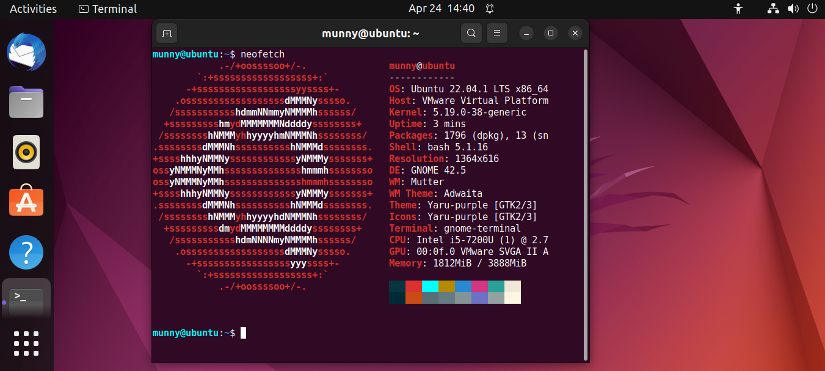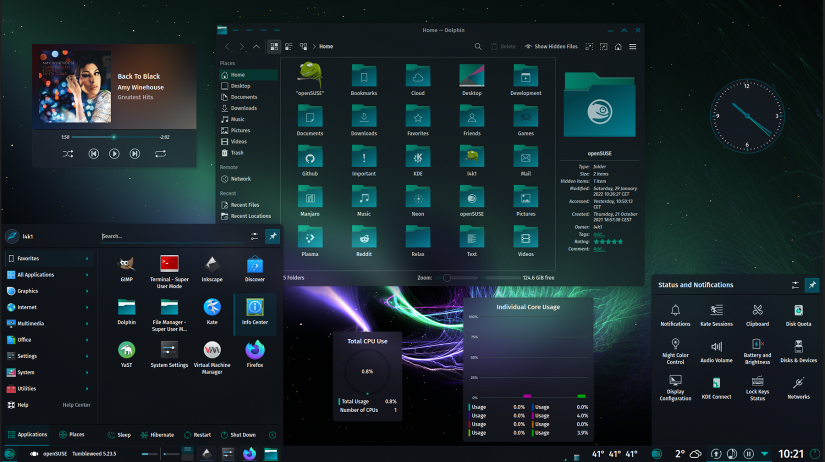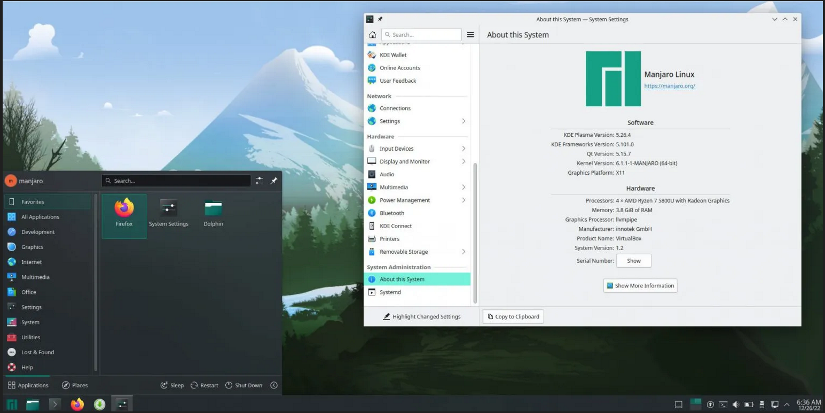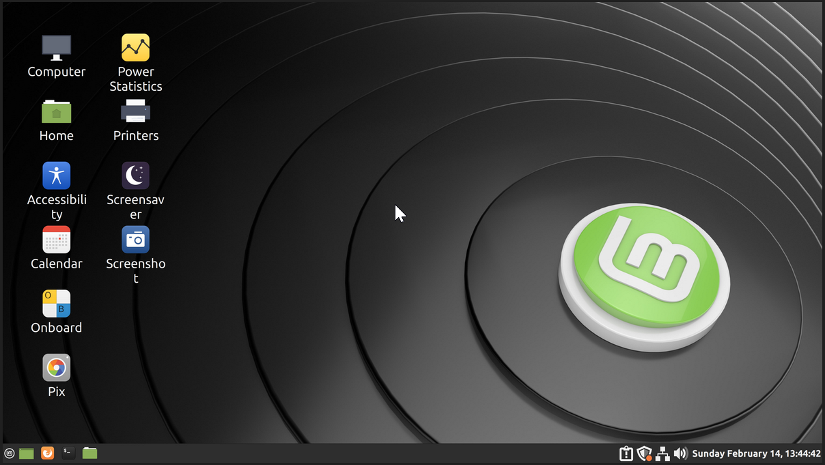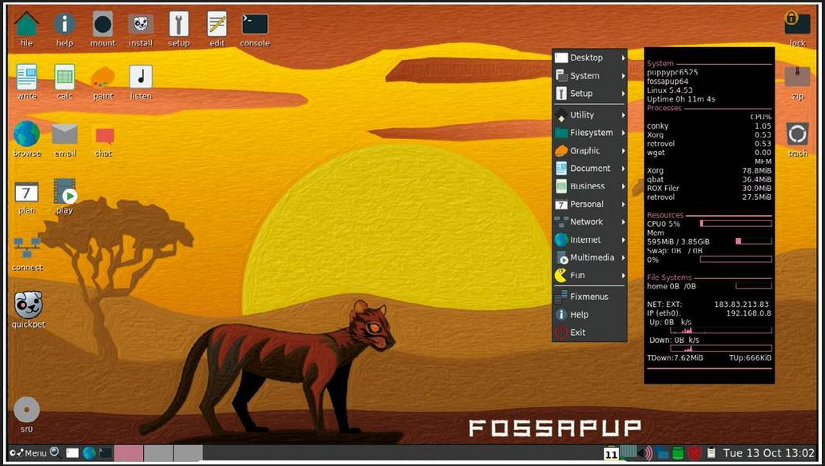Developers prefer Linux for a variety of reasons. For instance, Linux provides better support for programming languages and tools, and it is more secure. Moreover, it is open source, allowing developers to access and modify the source code and then customize it according to their needs. In addition, it is less resource-hungry and has a large and active community. A developer chooses a Linux distro differently than a regular user. In this article, I have tried to list some of the top Linux distro for developers.
What is a Distro in Linux?
In Linux, a distro is a combination of Linux kernel and GNU programs. There is a common misconception that Linux is an operating system. However, that is not true. Linux is a kernel. A kernel is a piece of code, the core of an operating system, that communicates with the hardware. Whenever someone refers to Linux distros it means operating systems based on the Linux kernel. A Linux There are a lot of Linux distros out there, every one providing different features and flexibilities.
Factors Developers Consider to Choose Their Linux Distro
Different person has diverse needs and preferences. Similarly, different Linux distro offers various features to suit people’s needs. That is why it is not easy to pick the best distros out of hundreds. Here I am taking the following approach. At first, I tried to outline the factors developers like and dislike. Then I used those factors to list the top distros.
Factors Developers Like
Here is the list of things developers want to have in their Linux Distro:
- Availability of tools and libraries: Developers may want to use a Linux distro that has a large and updated repository of software packages that they can easily install and use. Moreover, they may use distros that support their preferred languages and frameworks.
- Stability and security: Developers prefer to use a Linux distro that is stable and secure, does not crash frequently, or has major bugs or vulnerabilities. Additionally, they look for Distro that has regular updates and patches to fix any issues or improve performance.
- Ease of Installation and Configuration: Developers search for a Linux distro that is easy to install and configure, and has features such as user-friendly installers, and Graphical User Interface (GUI).
- Customization and control over the Distro: Developers want to use a Linux distro that allows customizing and control of a system. Furthermore, they look for a system with flexible and powerful tools for tweaking and optimizing the system.
- Compatibility and support for their hardware and software: Developers look for a distro that is compatible and supported by their hardware and software. For instance, a developer would want a distro that has drivers and firmware for his devices, such as printers, scanners, graphics cards, etc.
Factors Developers Dislike
Here is the list of things developers don’t want to have in their Linux Distro:
- Bloatware: Unnecessary software or features that consume system resources and slow down performance.
- Outdated Software: Software that is not updated regularly or compatible with the latest technologies.
- Complex installation or configuration: Installation or configuration processes that are time-consuming, tedious, and require advanced skills.
- Lack of compatibility or support: Not compatible with some applications or devices.
- Inconsistency or instability: Frequently changes or crushes or contains bugs that affect the functionality or appearance of the system or applications.
6 Best Linux Distros For Developers
In this section, I have listed the top 6 best Linux distros for developers based on the factors mentioned above.
1. Ubuntu
Ubuntu is an open-source Linux distro that runs on PCs, servers, cloud, etc. It is designed for personal and professional use and comes in different versions and flavors. For example, the Ubuntu Desktop has a user-friendly interface and many applications for personal use, whereas the Ubuntu server is optimized for cloud computing and web hosting.
Download Ubuntu
Click here to visit Ubuntu’s official download page.
Key Features of Ubuntu
- Open Source: Ubuntu is free and open source and can be used on computers, servers, cloud computing, and IoT devices.
- GNOME Desktop Environment: It provides a user-friendly environment and supports other environments such as KDE, Xfce, and MATE.
- Apps: It has thousands of apps available to download including Spotify, Firefox, LibreOffice, VLC, Slack, Atom, and Telegram.
- Protection: It protects users from viruses, malware, and data breaches. Users can also encrypt their hard drives and use VPN services.
- LibreOffice: It updates every six months and provides new features, bug fixes, and security patches. It also provides Long-term Support (LTS) versions that receive updates for five years.
- Lightweight: It requires minimal hardware resources to run smoothly and fast.
Pros of Ubuntu
- It has a large and diverse repository of software packages and libraries for various programming languages. It also supports the snaps package.
- Developing tools, such as Visual Studi Code can easily be installed.
- It comes with Python, Rust, Ruby, Go, PHP, and Perl, and supports frameworks like OpenCV, TensorFlow, Keras, PyTorch and Kubeflow.
- It is stable and secure and receives regular updates and long-term support.
- It is easy to install, and its simple intuitive graphical interface makes it easy to use and customize.
- It is compatible with a wide range of hardware, such as laptops, desktops, workstations, servers, cloud and internet devices.
Cons of Ubuntu
- It has packages that a user might find unnecessary and unwanted, such as the Amazon app, Game and media players, and old kernel versions.
- The repository may not be up to date with the latest versions of software.
- May not work well with devices such as fingerprint scanners or webcams.
2. openSUSE
openSUSE is a Linux distro that is designed for developers, sysadmins, and desktop users. It has two main distributions: Tumbleweed and Leap. Tumble is a rolling release and Leap is a stable release. Furthermore, it has MicroOS and Leap Micro, which are micro-service operating systems for cloud and edge computing. In addition, it offers desktop environments, such as KDE Plasma, GNOME, and Xfce.
Download openSUSE
Click here to visit openSUSE’s official download page.
Key Features of openSUSE
- Two Flavors: OpenSUSE comes in two editions: Lead and Tumbleweed. Leap is stable and Tumbleweed is a rolling that provides the latest software.
- YaST: YaST is an installation and configuration tool that makes openSUSE easy to set up and customize. YaST can handle everything from partitioning, networking, security, software management, system updates, and more.
- RPM Package Management: It uses the RPM package format to manage software installation and removal. Additionally, RPM packages are compatible with other Linux distros such as Fedora and Red Hat.
- Different choice of Desktop: It supports a variety of desktop environments, such as KDE Plasma, GNOME, Xfce, LXQt, MATE, Cinnamon, and Enlightenment.
- microOS: microOS is a minimal and immutable operating system that is designed for containerized and cloud-native applications.
Pros of openSUSE
- It has a large and diverse software repository that covers most of the popular languages and frameworks, such as Python, Ruby, Java, C#, js, Django, Rails, Spring Boot, etc.
- It provides Open Build Service (OBS), which is a platform for creating and distributing software packages.
- It has a Tumbleweed release for developers with the newest versions.
- It has a Leap release for developers who value stability and reliability.
- It supports various installation modes, such as graphical, text-based, or network-based.
- A developer can easily customize a system from configuration files or graphical tools.
- It supports a wide range of hardware devices, including SSDS, HDDS, NVMe Drives, RAID arrays, Ethernet cards, and Wi-Fi adapters.
Cons of openSUSE
- It comes with tons of software, including games, office, and multimedia applications, which a developer may find unnecessary.
- As openSUSE Leap is a stable distribution, it may contain some outdated
- The installer settings have a complex partitioning scheme and bootloader configuration.
- It may not be compatible with newer or less common hardware, such as Apple M1 chips, or Raspberry Pi 4.
3. Manjaro
Manjaro is a free and open-source Linux operating system based on Arch Linux, which is known for simplicity, flexibility, and cutting-edge software. It aims to be user-friendly and accessible. Manjaro doesn’t have fixed versions as it uses the rolling release model. It has server graphical user interfaces such as Plasma, Xfca, and GNOME.
Download Manjaro
Click here to visit Manjaro’s official download page.
Key Features of Manjaro
- Based on Arch Linux: It inherits the speed, power, efficiency, and access to the latest software of Arch Linux.
- Rolling Release Model: It updates its system continuously.
- Multiple Desktop Environments: It has various desktop environments to suit different preferences and needs, such as Xfce, KDE Plasma 5, GNOME, Plasma Mobile, and Phosh.
- Calamares: Calamares is Manjaro’s default graphical installer and it is easy to use and supports various features such as encryption, partitioning, and localization.
- Pamac: Pamac is a graphical package manager that can install or remove software in an easy and simple way.
- MHWD: MHWD is a hardware detection and configuration tool that can automatically install the appropriate drivers for your system. It also allows a user to switch between different kernel versions and graphics drivers.
Pros of Manjaro
- It utilizes its native packages, Flatpak or Snap to provide a wide of libraries and frameworks for various programming languages.
- a developer can take advantage of the Arch User Repository (AUR) which contains thousands of user-contributed packages.
- As it uses the rolling release model, a developer can be up to date with new features and bug fixes.
- It is easy to install and configure.
- It provides a lot of flexibility and control over the system, where a developer can choose from different desktop environments, themes, icons, fonts, and more.
- It supports most of the common hardware components and peripherals.
- Manjaro does not come with much bloatware.
Cons of Manjaro
- As it does not provide any stable release, its updates may introduce instability and compatibility issues.
- Some hardware may require manual installation of proprietary drivers or firmware.
4. Linux Mint
Linux Mint is a Linux Distro for desktops and laptops which comes with apps most people need. It gives a user Windows-like flavors and it is free of cost and open-source. Cinnamon is the main edition of Linux Mint which offers a modern and innovative desktop. Whereas, MATE and Xfce are lightweight and suitable for less powerful hardware.
Download Linux Mint
Click here to visit LinuxMint’s official download page.
Key Features of Linux Mint
- Cinnamon Desktop: Cinnamon Desktop is designed to be easy to use and highly customizable.
- Wide Range of Applications: It offers a wide range of applications, including browsers, offices, media players, and more.
- Long-Term Support (LTS): It releases LTS which are normally supported for a duration of 5 years.
- Free and Open Source: It is completely free of cost and almost all of its components are open source.
Pros of Linux Mint
- It supports a variety of programming languages and frameworks such as C, Python, Javascript, Vala, GTK3, GNOME, Qt, and more.
- It provides developing tools such as IDE, editors, debuggers, compilers, etc; Some examples of them are Netbeans, Sublime Text, Visual Studio Code, Eclipse, git, gitk, npm, and Wine.
- It has an update manager which allows users to choose the level of updates they want to apply.
- It provides guides to install and configure the system.
- It comes with all the essential applications, with no requirement for any additional configuration or installation.
- A developer can customize appearance and behavior using themes, icons, widgets, applets, desklets, and extensions.
- It is compatible with most hardware from low-end to high-end.
Cons of Linux Mint
- Some developers might find some of the applications or features unnecessary.
- The official repositories might be outdated or behind the latest releases.
5. Puppy Linux
Puppy Linux is a family of Linux distributions that are designed for home users and have low system requirements. It is a useful platform for creating and testing applications for different environments and architectures. It also has a system builder named Woof-CE that allows a developer to build his own custom Puppy Linux.
Download Puppy Linux
Click here to visit Puppy Linux’s official download page.
Key Features of Puppy Linux
- Light-Weight: It focuses on ease of use and minimal memory footprint.
- Can Run on RAM: It can entirely run on RAM taking up about 600 MB, and 300 MB which allows the boot medium to be removed after the operating system.
- Common Daily Apps: It comes with daily apps you need, such as AbiWord, Gnumeric, and Mplayer, along with lightweight browsers and downloading utilities.
- Highly Customizable: It is customizable within minutes with a selection of themes and desktop wallpapers.
- Puplets: Puppy Linux has different variants or puplets to suit different needs.
- Installable on Bootable Storage Media: It can be installed on various bootable storage media, such as CD-ROM, USB, flash drive, SD card, etc.
Pros of Puppy Linux
- It comes with some common tools and libraries for programming, such as Bash, Python, Qt, and GTK.
- It is generally stable.
- It only runs in RAM and does not write on the hard disk.
- It is very easy to install and can be installed from a CD, DVD, or USB drive.
- It can save all the settings in a single file which can be stored later.
- Highly customizable and a developer can build his own version of Puppy Linux using the Woof-CE
- It runs on old and new computers, even in Raspberry Pi.
Cons of Puppy Linux
- It does not have all the tools and libraries that a developer requires.
- It may not receive regular security updates or patches.
- Some versions of Puppy Linux have outdated software.
- Some versions of Puppy Linux may not be stable or consistent across different flavors, variants, or derivatives.
6. Pop!_OS
Pop!_OS is a Linux distro based on Ubuntu and it is designed to be user-friendly, easy to install, and optimized for performance and productivity. It has some tweaks and enhancements to improve the user experience.
Download Pop!_OS
Click here to visit Pop!_OS’s official download page.
Key Features of Pop!_OS
- COSMIC: COSMIC is a customized GNOME desktop environment that comes with Pop!_OS.
- Supports AMD and Nvidia GPUs: It supports AMD and Nvidia GPUs and has packages that allow easy setup of TensorFlow and CUDA.
- APT and Flatpak: APT and Flatpak are package management tools that help users to install, remove and update software.
- GUI toggle: This feature lets users switch between different video modes.
- Power Management Package: This feature optimizes the system performance and battery life based on the user’s preferences.
- Recovery Partition: The recovery partition is a full copy of the installation disk that can be used to repair or reinstall the system.
- Automatic Tiling: Automatic Tiling organizes the windows on the screen in a grid-like pattern, maximizing the use of screen space and reducing clutter.
Pros of Pop!_OS
- It supports most programming languages, such as Python, Java, C/C++, Rust, Go, Ruby, PHP, js, Django, Flask, Rails, etc.
- It comes with a variety of development toolkits such as Visual Studio Code, ROS, Postman, KiCad, Android Studio, Arduino IDE, TensorFlow, PyTorch, Caffe, Jupyter, MATLAB, Blender, Davinci Resolve, Inkscape, Lightworks, Natron, R, Bioconda, Uniplot, Bowtie 2 and Biopython.
- As it is based on Ubuntu, its releases are stable.
- It provides full disk encryption capability to ensure the security of user data.
- It has a desktop environment called COSMIC that allows a user to customize workflow with keyboard shortcuts, auto-tiling windows, workspaces, and stacking.
- It can run most of the software applications available for Linux.
Cons of Pop!_OS
- It may have some outdated software packages compared to other Linux Distro.
- It may require complex installation or configuration steps.
- It does not provide a graphical tool for managing drivers, boot, and grub
- It may not work well with some devices that require proprietary drivers or firmware not available in the Linux kernel or Ubuntu
- Its frequent updates may cause inconsistency or instability issues.
Comparative Analysis of Best Distros for Developers
Check out the following developing tools provided by different distros:
If you are a developer looking for the best Linux Distro this article might be helpful for you. However, remember the best Linux Distro is the one that matches your personal preferences, tastes, and flavors. Debian Linux is the most stable distro. It is user-friendly, lightweight, and compatible. In addition, it ensures bug fixes and security updates before releasing a new version. Some of the harvest Linux distros are Gentoo, Arch Linux and Slackware. Arch Linux is hard because it requires to install and configuration manually. Meanwhile, Slackware and Gentoo don’t provide any graphical installer and require users to install and configure software from source code. Linux has several advantages over Windows that make it faster. It is open source, lightweight, highly customizable, and optimizable, whereas Windows isn’t lightweight as it comes with a lot of features and services that may not be needed for all users. Moreover, Linux is more resistant to malware than Windows. Furthermore, Linux can run on a very low configuration. Ubuntu is a complete desktop Linux operating system and the most-known distribution. It has a huge community compared to others.
Linux Distro
Tools
Ubuntu
Juju, Microk8s, Multipass, Snapcraft, Qt Creator, KDevelop, Netbeans, Albert
openSUSE
Open Build Service, openQA, YaST, Kiwi, Eclipse, KDevelop, Netbeans
Manjaro
Manjaro Tools, buildiso, buildpkg, buildset, Qt Creator, KDevelop, Netbeans
Linux Mint
Linux Tools for Developers, Seamonkey Composer, Pinegrow, Eclipse, Netbeans
Puppy Linux
Puppy Linux Home, Woof-CE, Seamonkey Composer, Geany, Devx SFS
Pop!_OS
Pop!_OS by System76, Pop Shell, Tensorman, VS Code, ROS
Conclusion
People Also Ask
Which Linux OS is most stable?
What is the hardest Linux distro?
Why Linux is so fast than Windows?
What is the largest Linux community?
FUNDAMENTALS
A Complete Guide for Beginners

